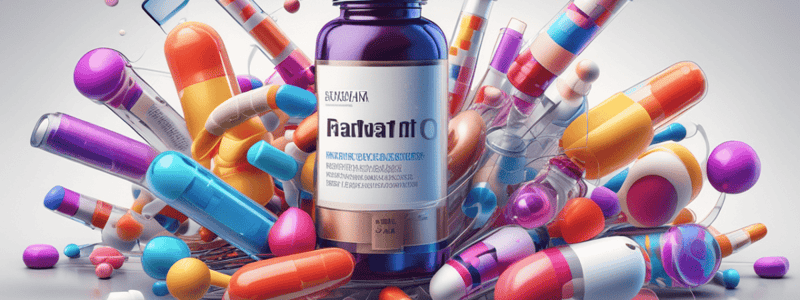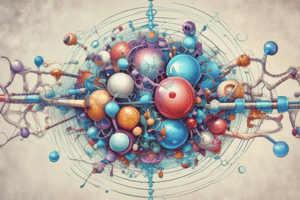Podcast
Questions and Answers
Pharmacodynamics is the division of pharmacology that studies what the body does to the drug.
Pharmacodynamics is the division of pharmacology that studies what the body does to the drug.
False (B)
Most drugs are effective because they bind to specific target proteins like enzymes, carriers, and ion channels.
Most drugs are effective because they bind to specific target proteins like enzymes, carriers, and ion channels.
True (A)
Cytotoxic drugs work by stimulating physiological functions.
Cytotoxic drugs work by stimulating physiological functions.
False (B)
Bulk laxatives exert their mechanism of action through chemical interactions.
Bulk laxatives exert their mechanism of action through chemical interactions.
Enzymes can be inhibited by both competitive and non-competitive inhibition.
Enzymes can be inhibited by both competitive and non-competitive inhibition.
Epinephrine acts on alpha receptors in the heart.
Epinephrine acts on alpha receptors in the heart.
Competitive antagonism results in a curve that shifts to the left without a change in slope.
Competitive antagonism results in a curve that shifts to the left without a change in slope.
Non-competitive antagonism can be reversed by increasing the concentration of the agonist drug.
Non-competitive antagonism can be reversed by increasing the concentration of the agonist drug.
Tachyphylaxis refers to a gradual increase in responsiveness to a drug over time.
Tachyphylaxis refers to a gradual increase in responsiveness to a drug over time.
Irreversible antagonism is characterized by the drug binding to an allosteric site on the receptor.
Irreversible antagonism is characterized by the drug binding to an allosteric site on the receptor.
Tolerance is a phenomenon that develops within minutes of drug administration.
Tolerance is a phenomenon that develops within minutes of drug administration.
Competitive antagonism involves drugs that exert an antagonistic effect without competing for receptor occupancy.
Competitive antagonism involves drugs that exert an antagonistic effect without competing for receptor occupancy.
Partial agonists have low affinity and high intrinsic activity.
Partial agonists have low affinity and high intrinsic activity.
Antagonists bind to receptors and elicit tissue responses.
Antagonists bind to receptors and elicit tissue responses.
High affinity drugs bind well and remain long enough to activate receptors.
High affinity drugs bind well and remain long enough to activate receptors.
Antagonists have high affinity but no intrinsic activity.
Antagonists have high affinity but no intrinsic activity.
Full agonists have low intrinsic activity and low affinity.
Full agonists have low intrinsic activity and low affinity.
Potency refers to the intensity of the drug effect produced by a given amount or dose of the drug.
Potency refers to the intensity of the drug effect produced by a given amount or dose of the drug.
The process of down regulation of receptors occurs due to excessive exposure to antagonists.
The process of down regulation of receptors occurs due to excessive exposure to antagonists.
Exhaustion of mediators can lead to an increase in essential immediate substances.
Exhaustion of mediators can lead to an increase in essential immediate substances.
Increased metabolic degradation results in a progressive increase in plasma concentration of a drug.
Increased metabolic degradation results in a progressive increase in plasma concentration of a drug.
Therapeutic Index (TI) is calculated as TD50 / ED50.
Therapeutic Index (TI) is calculated as TD50 / ED50.
Nicotinic receptor is an example of a receptor linked to G-proteins.
Nicotinic receptor is an example of a receptor linked to G-proteins.
The rate at which drugs act depends on the dose administered.
The rate at which drugs act depends on the dose administered.
G-protein-coupled receptors mainly use cAMP and IP3 as their principal third messengers.
G-protein-coupled receptors mainly use cAMP and IP3 as their principal third messengers.
Adenylate cyclase catalyzes the conversion of cAMP to ATP.
Adenylate cyclase catalyzes the conversion of cAMP to ATP.
IP3 is responsible for controlling the release of sodium ions from intracellular stores.
IP3 is responsible for controlling the release of sodium ions from intracellular stores.
Kinase-linked receptors are mainly involved in events controlling cell death.
Kinase-linked receptors are mainly involved in events controlling cell death.
The Jak/Stat pathway is activated by many cytokines and controls the synthesis and release of many anti-inflammatory mediators.
The Jak/Stat pathway is activated by many cytokines and controls the synthesis and release of many anti-inflammatory mediators.
The insulin receptor autophosphorylates in response to insulin.
The insulin receptor autophosphorylates in response to insulin.
Flashcards are hidden until you start studying
Study Notes
Pharmacodynamics Overview
- Studies how the body affects drugs and their mechanisms of action.
- Drug efficacy primarily depends on binding to specific target proteins, including enzymes, carriers, and ion channels.
Mechanisms of Drug Action
- Cytotoxic drugs enhance physiological functions to exert their effects.
- Bulk laxatives operate through chemical interactions.
- Enzymatic activity can be modulated by competitive and non-competitive inhibition.
- Epinephrine specifically targets alpha receptors in the heart.
Types of Antagonism
- Competitive antagonism shifts drug response curves to the left without altering slope.
- Non-competitive antagonism can be reversed by increasing agonist concentration.
- Irreversible antagonism involves drugs binding to allosteric sites on receptors.
Drug Response and Tolerance
- Tachyphylaxis refers to diminished responses to a drug after repeated dosage over time.
- Tolerance can develop quickly, sometimes within minutes of administration.
Agonists and Antagonists
- Competitive antagonists block receptor activity without directly occupying receptors.
- Partial agonists possess low affinity combined with high intrinsic activity.
- Full agonists exhibit low intrinsic activity with low affinity.
- Antagonists can bind with high affinity but lack intrinsic activity, resulting in no tissue response.
Drug Potency and Efficacy
- Potency indicates the degree of drug effect relative to the dosage.
- Therapeutic Index (TI) calculated as TD50 (toxic dose for 50% of the population) divided by ED50 (effective dose for 50%).
Receptor Dynamics
- Downregulation of receptors occurs with excessive exposure to antagonists.
- Exhaustion of mediators increases the demand for essential immediate substances.
- Enhanced metabolic degradation leads to elevated plasma concentrations of a drug.
Receptor Types and Signaling Pathways
- Nicotinic receptors are an example of receptors associated with G-proteins.
- G-protein-coupled receptors predominantly use cAMP and IP3 as third messengers.
- Adenylate cyclase catalyzes cAMP conversion to ATP.
- IP3's role includes regulating sodium ion release from intracellular stores.
- Kinase-linked receptors play a key role in processes linked to cell death.
- The Jak/Stat pathway is triggered by various cytokines, controlling the synthesis of anti-inflammatory mediators.
- The insulin receptor undergoes autophosphorylation upon insulin binding.
Studying That Suits You
Use AI to generate personalized quizzes and flashcards to suit your learning preferences.




